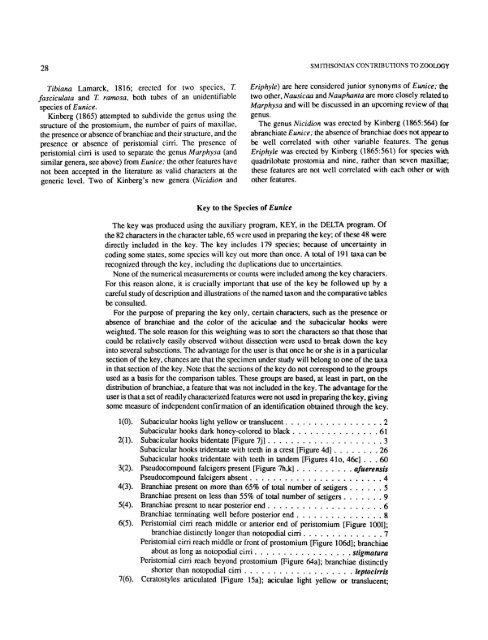A Review of the Genus Eunice - Smithsonian Institution Libraries
A Review of the Genus Eunice - Smithsonian Institution Libraries
A Review of the Genus Eunice - Smithsonian Institution Libraries
Create successful ePaper yourself
Turn your PDF publications into a flip-book with our unique Google optimized e-Paper software.
28<br />
SMITHSONIAN CONTRIBUTIONS TO ZOOLOGY<br />
Tibiana Lamarck, 1816; erected for two species, T.<br />
fasciculata and T. ramosa, both tubes <strong>of</strong> an unidentifiable<br />
species <strong>of</strong> <strong>Eunice</strong>.<br />
Kinberg (1865) attempted to subdivide <strong>the</strong> genus using <strong>the</strong><br />
structure <strong>of</strong> <strong>the</strong> prostomium, <strong>the</strong> number <strong>of</strong> pairs <strong>of</strong> maxillae,<br />
<strong>the</strong> presence or absence <strong>of</strong> branchiae and <strong>the</strong>ir structure, and <strong>the</strong><br />
presence or absence <strong>of</strong> pcrislomial cirri. The presence <strong>of</strong><br />
peristomial cirri is used to separate <strong>the</strong> genus Marphysa (and<br />
similar genera, see above) from <strong>Eunice</strong>; <strong>the</strong> o<strong>the</strong>r features have<br />
not been accepted in <strong>the</strong> literature as valid characters at <strong>the</strong><br />
generic level. Two <strong>of</strong> Kinberg's new genera (Nicidion and<br />
Eriphyle) are here considered junior synonyms <strong>of</strong> <strong>Eunice</strong>; <strong>the</strong><br />
two o<strong>the</strong>r, Nausicaa and Nauphanta are more closely related to<br />
Marphysa and will be discussed in an upcoming review <strong>of</strong> that<br />
genus.<br />
The genus Nicidion was erected by Kinberg (1865:564) for<br />
abranchiate <strong>Eunice</strong>; <strong>the</strong> absence <strong>of</strong> branchiae does not appear to<br />
be well correlated with o<strong>the</strong>r variable features. The genus<br />
Eriphyle was erected by Kinberg (1865:561) for species with<br />
quadrilobate prostomia and nine, ra<strong>the</strong>r than seven maxillae;<br />
<strong>the</strong>se features are not well correlated with each o<strong>the</strong>r or with<br />
o<strong>the</strong>r features.<br />
Key to <strong>the</strong> Species <strong>of</strong> <strong>Eunice</strong><br />
The key was produced using <strong>the</strong> auxiliary program, KEY, in <strong>the</strong> DELTA program. Of<br />
<strong>the</strong> 82 characters in <strong>the</strong> character table, 65 were used in preparing <strong>the</strong> key; <strong>of</strong> <strong>the</strong>se 48 were<br />
directly included in <strong>the</strong> key. The key includes 179 species; because <strong>of</strong> uncertainty in<br />
coding some states, some species will key out more than once. A total <strong>of</strong> 191 tax a can be<br />
recognized through <strong>the</strong> key, including <strong>the</strong> duplications due to uncertainties.<br />
None <strong>of</strong> <strong>the</strong> numerical measurements or counts were included among <strong>the</strong> key characters.<br />
For this reason alone, it is crucially important that use <strong>of</strong> <strong>the</strong> key be followed up by a<br />
careful study <strong>of</strong> description and illustrations <strong>of</strong> <strong>the</strong> named taxon and <strong>the</strong> comparative tables<br />
be consulted.<br />
For <strong>the</strong> purpose <strong>of</strong> preparing <strong>the</strong> key only, certain characters, such as <strong>the</strong> presence or<br />
absence <strong>of</strong> branchiae and <strong>the</strong> color <strong>of</strong> <strong>the</strong> aciculae and <strong>the</strong> subacicular hooks were<br />
weighted. The sole reason for this weighting was to sort <strong>the</strong> characters so that those that<br />
could be relatively easily observed without dissection were used to break down <strong>the</strong> key<br />
into several subsections. The advantage for <strong>the</strong> user is that once he or she is in a particular<br />
section <strong>of</strong> <strong>the</strong> key, chances are that <strong>the</strong> specimen under study will belong to one <strong>of</strong> <strong>the</strong> taxa<br />
in that section <strong>of</strong> <strong>the</strong> key. Note that <strong>the</strong> sections <strong>of</strong> <strong>the</strong> key do not correspond to <strong>the</strong> groups<br />
used as a basis for <strong>the</strong> comparison tables. These groups are based, at least in part, on <strong>the</strong><br />
distribution <strong>of</strong> branchiae, a feature that was not included in <strong>the</strong> key. The advantage for <strong>the</strong><br />
user is that a set <strong>of</strong> readily characterized features were not used in preparing <strong>the</strong> key, giving<br />
some measure <strong>of</strong> independent confirmation <strong>of</strong> an identification obtained through <strong>the</strong> key.<br />
1(0). Subacicular hooks light yellow or translucent 2<br />
Subacicular hooks dark honey-colored to black 61<br />
2(1). Subacicular hooks bidentate [Figure 7j] 3<br />
Subacicular hooks tridentate with teeth in a crest [Figure 4d] 26<br />
Subacicular hooks tridentate with teeth in tandem [Figures 41o, 46c] ... 60<br />
3(2). Pseudocompound falcigers present [Figure 7h,k] afuerensis<br />
Pseudocompound falcigers absent 4<br />
4(3). Branchiae present on more than 65% <strong>of</strong> total number <strong>of</strong> setigers 5<br />
Branchiae present on less than 55% <strong>of</strong> total number <strong>of</strong> setigers 9<br />
5(4). Branchiae present to near posterior end 6<br />
Branchiae terminating well before posterior end 8<br />
6(5). Peristomial cirri reach middle or anterior end <strong>of</strong> peristomium [Figure 1001];<br />
branchiae distinctly longer than notopodial cirri 7<br />
Peristomial cirri reach middle or front <strong>of</strong> prostomium [Figure 106d]; branchiae<br />
about as long as notopodial cirri<br />
stigmatura<br />
Peristomial cirri reach beyond prostomium [Figure 64a]; branchiae distinctly<br />
shorter than notopodial cirri<br />
leptocirris<br />
7(6). Ceratostyles articulated [Figure 15a]; aciculae light yellow or translucent;
















